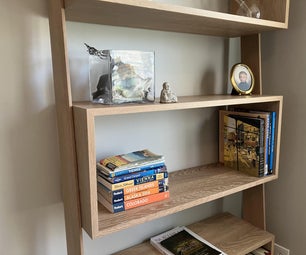Introduction: How to Make a Hanging Baffle
Overview
Team: Wenzhe Peng, Dairan Xu
Instructors: Kyle Steinfeld, Simon Schleicher, Jonathan Bachrach, Luis Jaggy
The environment baffle we made is a bending structure hanging to the ceiling, which is used to provide a private feeling in a public space. It can either be big enough to allow two people in, or just one person. Depending on its height, one may feel more private or more exposed, with different posture. The compiler starts with polyhedron shape, unroll the shape and converts it to the module we designed, with its joints system, and lay it out that can directly be fabricated.
Step 1: Generating Geometry
We use grasshopper to generate a series of polyhedron shapes. Firstly, we create some random points and let them distributed uniformly on the surface of a sphere. Secondly we use these points as centers to create a facetted dome and evaluate the lines between the center and the vertices of the dome at a specified parameter. Then we draw circles on the evaluated points and extrude them to cylinders. Finally we perform a solid difference on the dome and these cylinders to get a polyhedron shape.
Step 2: Choosing Geometry
The second step is to choose a shape from a design space of shapes that the first step generated. Since the basic module works better with regular polygon,we use galapagos to minimize the variance of different edges. Also, we can control the complexity of the final shape by choosing polyhedrons with different surfaces.
Step 3: Unroll
We use the UnrollBreps component in Grasshopper to unroll the shape we choose.
Step 4: Generate Cutting Pattern
The compiler then apply the cutting pattern of the basic module to the unrolled shape and generate the cutting pattern for Zund. At the same time the compiler can generate the connection part to bend the main structure.
Step 5: Manufacturing With Zund
The material we use is 4*4 clear polycarbonate and we use Zund to cut the material.
Step 6: Paint
To differentiate the inside and the outside surface of the structure, we need to paint the material with white and yellow. We paint the material white with spray paint first and when the white paint is dry we paint the material yellow at the same side of the material. In this way, we can keep the clean look of the material at outside while paint the structure with two different colors.
Step 7: Module Assembly
Put the triangle connection to the module to keep a bending shape
Step 8: Pieces Connection
Use brass fastener to connect different modules.
Step 9: Hanging With Cable
Use top clam and J-hook cable to hang the structure from the ceiling
Step 10: Final Project
Step 11: Previous Studies_Double-layered Structure
The following images will be associated with Double-layered Structure studies
Step 12: Double Layered Mechanism Study
Here we did a force decomposition.
We can see that the upper layer is compressed in the middle.
For the bottom layer, the horizontal force is reversed, thus the bottom layer is stretched.
Step 13: Bending Simulation
The basic mechanism of double-layered structure is to use two layers with different length to form a pre-determined shape. This is a simulation of a star-shaped module we made for it.
Step 14:
Step 15: Joint
We use Bolt, nut, washer, and spacer in our project to fix the strips. The washers can reduce the stress at the edge of the hole in the strip and prevent the joints from breaking.
Step 16: Material Test
We use multiple material to do the module test. Wood is easy to bend along the grain but it is also easy to break at the other direction because of the natural orientation of material. Chip Board is not strong enough for bending and will buckle in the middle of the module. Process Board works fine in this test but will also buckle in the middle if it bend too much. Styrene and Clear Plastic seems to be the suitable material for this module because artificial material do not have specific orientation and it is more flexible than other materials.
Step 17: Module Test
Here is some module test we made. Each group has same length of bottom layer and three different length of upper layer. In the test of Group A. As the Upper layer increase, the strip will bend more, as we calculate before. The third drawing shows the test of Group A and B. The Upper Row have shorter length of the bottom but the difference between two layers is the same. Mathematically, the upper row and the lower row should bend at the same angle. But the longer strips bend less than we expected. We assume that the weight of the module cause the deformation and the longer the strip is the more it will deform.
Step 18: Bending Shape Simulation
Step 19: Vector Angle Calculation
Vector_A = (v1+v2+v3+v4+vO+v11+v12).normalized()
Vector_O = Vector_ABC.normalized()
In order to use the module we designed to bend to match the shape of the mesh, we need to calculate the vector direction of each vertex. The vector of centroid is equals to the normal vector of the triangle itself, which can be calculated by cross product. And the vector of each vertex is equals to the overall vector of all neighboring triangles. Like vector A is equals the mean of all normal vectors in the red zone.
Step 20: Strip Length Calculation Based on Vector Angle
Cos α = V_P
X V_B / || V_P || ||V_B||
r = L1 / α
L2 = (r + d) * α
Getting all the vectors we need, using
the previous technique, we can easily calculate L2, the length of upper layer strip.
Step 21: Compiler Video
Step 22: Manufacturing With Laser
The material we use for this model is cardboard and we use laser cutter to manufacturing it. The bottom layer is cut as a whole piece, and upper layer modules are attached upon it to bend to the predetermined shape.
Step 23: Assembling
Step 24: Prototype
Step 25: Module Development
These are the modules that we tested during the process, we try to get rid of additional joints like bolts and nuts, and use customized joints to force the bending mechanism.







